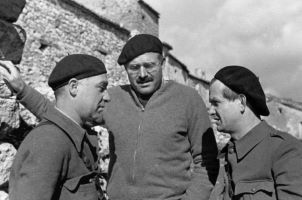
Whether you are planning to travel to the Hemingway Society Conference in Bilbao and San Sebastian next week or you just wish you were, here’s a suggested starter reading list of articles on Hemingway and Spanish culture. This list is not intended to be comprehensive; instead, use it and the previous blog post on books and films as starting points to find the many worthy books and articles left off these lists.
Articles
Buckley, Ramón. “Revolution in Ronda: The Facts in Hemingway’s For Whom the Bell Tolls.” Hemingway Review vol. 17, no. 1, 1997, pp. 49-57.
A comparison of the massacre of fascists (in the tale told by Pilar) to actual historical events in Ronda, based on field research, including local records and interviews with survivors.
Guill, Stacey. “Los Aviónes! The Interpretation of a New Warscape in The Spanish Earth, Picasso’s Guernica, and Hemingway’s For Whom the Bell Tolls.” Hemingway Review vol. 34, no. 1, 2014, pp. 13-29.
Recontextualizes Joris Ivens’s documentary, Picasso’s painting, and Hemingway’s novel as they depict the indiscriminate bombing of civilian populations.
Guill, Stacey. “ ‘Now You Have Seen It’: Ernest Hemingway, Joris Ivens, and The Spanish Earth.” Hemingway Review vol. 30, no. 1, 2010, pp. 51-68.
An examination of the collaborative nature of the making of the Spanish Civil War documentary that Hemingway wrote and narrated.
Guill Stacey. “Pilar and Maria: Hemingway’s Feminist Homage to the ‘New Woman of Spain’ in For Whom the Bell Tolls.” Hemingway Review vol. 30, no. 2, 2011, pp. 7-20.
A discussion of Hemingway’s female characters in the socio-political climate of Spain during its Civil War.
Guill, Stacey. “The Red and White Terrors: Civil War and Political Savagery in Ernest Hemingway’s For Whom the Bell Tolls.” Hemingway Review vol. 40, no. 1, 2020, pp. 29-52.
Discusses Maria’s rape and the massacre of fascists (as described by Pilar) and contextualizes them in relation to wartime atrocities committed in Spain during the Red and White Terrors.
Herlihy-Mera, Jeffrey. “ ‘He was sort of a joke, in fact’: Hemingway in Spain.” Hemingway Review vol. 31, no. 2, 2012, pp. 84-100.
A discussion of Spanish criticisms of Hemingway’s poor Spanish-language skills and his self-presentation as a bullfighting insider.
Herlihy-Mera, Jeffrey. “The Sun Also Rises: A Pilgrimage Novel.” Hemingway Review vol. 42, no. 2, 2023, pp. 25-55.
A comparison of the locations of Hemingway’s novel with the Camino de Santiago, the medieval pilgrimage also known in English as the Way of Saint James.
Josephs, Allen. “Confessions of an Animal Lover: Clearing up a Few Things About Hemingway, Spain, and the Bulls.” North Dakota Quarterly vol. 76, no. 1-2, 2009, pp. 77-89.
An edited version of the plenary address at the XII Hemingway Society Conference in Ronda, Spain, in June 2006.
Josephs, Allen. “Hemingway’s Spanish Sensibility.” The Cambridge Companion to Hemingway, ed. Scott Donaldson. Cambridge University Press, 1996, pp. 221-42.
A broad but detailed overview of the influence of Spain on Hemingway’s life and works.
Knodt, Ellen Andrews. “Diving Deep: Jake’s Moment of Truth at San Sebastian.” Hemingway Review vol. 17, no. 1, 1997, pp. 28-37.
A close reading of the two swimming scenes at San Sebastian near the end of The Sun Also Rises.
La Prade, Douglas E. “The Reception of Hemingway in Spain.” Hemingway Review vol. 11, no. 3, 1992, pp. 42-50.
Examines a series of Spanish reviews of Hemingway’s work, many of them critical.
Messent, Peter. “ ‘The Real Thing?’ Representing the Bullfight and Spain in Death in the Afternoon.” A Companion to Ernest Hemingway’s Death in the Afternoon, edited by Miriam B. Mandel. Camden House, 2004, pp. 123-41.
Argues that Hemingway explains premodern Spanish culture to a modernized American society much as an anthropologist would.
Nilsson, Anton. “Ernest Hemingway and the Politics of the Spanish Civil War.” Hemingway Review vol. 36, no. 1, 2016, pp. 81-93.
Tracks Hemingway’s development from an isolationist to a staunch supporter of democracy in Spain.
Twomey, Lisa A. “Taboo or Tolerable? Hemingway’s For Whom the Bell Tolls in Postwar Spain.” Hemingway Review vol. 30, no. 2, 2011, pp. 54-72.
An analysis of how Hemingway’s 1941 novel was received by Spanish critics.
Valis, Noël. “Hemingway’s The Fifth Column, Fifthcolumnism, and the Spanish Civil War.” Hemingway Review vol. 28, no. 1, 2008, pp. 19-32.
Argues that the fifth column at the heart of Hemingway’s play muddies its ethical core, so that it is unsuccessful both as political propaganda and as a morality play.
Vega, Jesus E. “The Influence of Spanish Writers on Hemingway.” Hemingway Review vol. 39, no. 2, 2020, pp. 63-77.
Contends that Hemingway was influenced by nineteenth-century Spanish writers known collectively as noventayochistas, including Pío Baroja, Vicente Blasco Ibáñez, and Azorín, among others.
Vernon, Alex. “Hemingway’s Spanish Civil War Dispatches.” The Mailer Review vol. 4, no. 1, 2010, pp. 427-44.
A sympathetic reevaluation of Hemingway’s journalism from Spain in the 1930s.
Vernon, Alex and Peter Davis. “The Spanish Earth and the Non-Nonfiction War Film.” Hemingway Review vol. 34, no. 1, 2010, pp. 57-75.
A study of the historical context of the documentary, based on field research, including site visits and local interviews.
Watson, William Brasch. “Joris Ivens and the Communists: Bringing Hemingway into the Spanish Civil War.” Hemingway Review vol. 10, no. 1, 1990, pp. 2-18.
A study of how Hemingway became involved with the Republican cause in the Spanish Civil War.
White, Frederick H. “Ideological Profit: Hemingway, Kol’tsov, and the Spanish Civil War.” Hemingway Review vol. 41, no. 1, 2021, pp. 43-67.
A discussion of how Hemingway’s depiction of the Spanish Civil War was received in the USSR.
Lisa Tyler coordinates The Hemingway Review blog and serves as secretary on the board of the Hemingway Society. She has published three books on Hemingway, including the edited collections Wharton, Hemingway, and the Advent of Modernism (Louisiana State University Press, 2019) and Teaching Hemingway’s A Farewell to Arms (Kent State University Press, 2008). She teaches at Sinclair Community College in Dayton, Ohio.